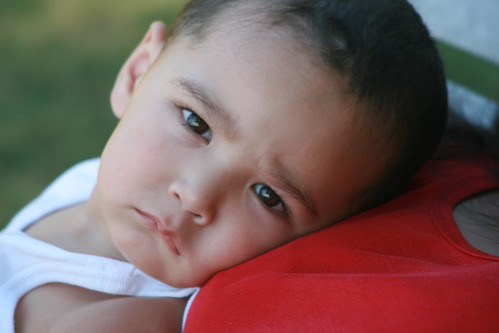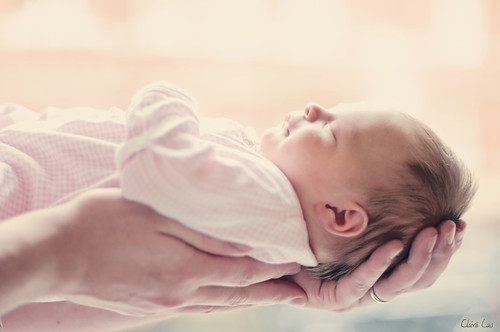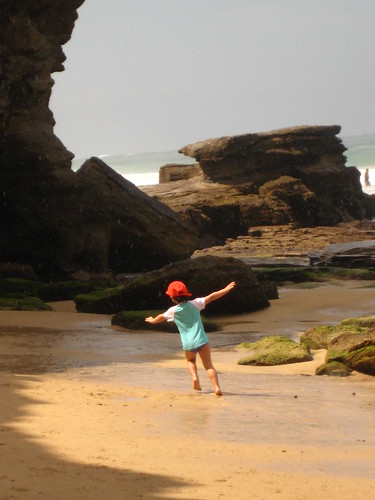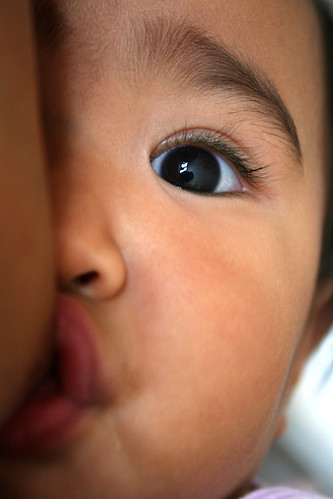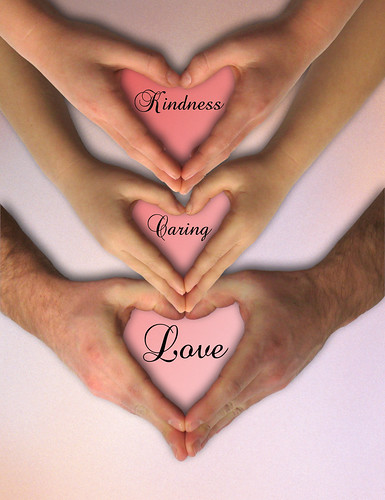 In “Peaceful Babies—Contented Mothers,” pediatrician Dr. Emmi Pikler asks us to consider the importance of the touch of our hands.
In “Peaceful Babies—Contented Mothers,” pediatrician Dr. Emmi Pikler asks us to consider the importance of the touch of our hands.
Hands continue the infant’s first connection to the world (outside of nursing). Hands pick her up, lay her down, wash and dress and maybe even feed her. How different it can be, what a different picture of the world an infant receives when quiet, patient, careful yet secure and resolute hands take care of her—and how different the world seems when hands are impatient, rough or hasty, unquiet and nervous. In the beginning, hands are everything for an infant. The hands are the person, the world. The way we touch a child, lift and dress her is “us” more precisely, more characteristically than even our words, or smile, or glance. If, from the start, we handle an infant peacefully, patiently, and carefully, she will discover ever more joy in these activities, learning at the same time to trust us more and more and to take an increasing part in our work.
To me, this begs the question: Should tickling, play wrestling, tossing a baby into the air, swinging a toddler by the arms, pillow fights- all activities otherwise known as roughhousing- have a place in the relationship between an adult and young child? Many Dads routinely engage in this kind of play with their children, and will tell you it is harmless fun, enjoyable for both adult and child, and that it is the way children naturally play. If you observe young animals at play, you will often see them tumbling together, and “play fighting.”
In fact, Dr. Larry Cohen, author of The Playful Parent, and co-author of the new book, The Art of Roughhousing, contends that roughhousing is actually beneficial for both children and parents in many ways:
“Roughhousing activates many different parts of the body and the brain, from the amygdalae, which process emotions, and the cerebellum, which handles complex motor skills, to the prefrontal cortex, which makes high-level judgments. The result is that every roughhousing playtime is beneficial for body and brain as well as for the loftiest levels of the human spirit: social awareness, cooperation, fairness, and altruism.”
In an interview with Megan Rosker (Let Children Play) Dr. Cohen says:
“I think that good quality roughhousing will make it more likely for a child to be kind and cooperative towards others, to be a good partner and parent, and to care about the community. The reason I believe this is that good roughhousing builds closer parent-child bonds, promotes confidence and empowerment, and solves family problems and behavior problems that can interfere with the child’s unfolding development.”
Roseann Murphy of Little River School had this to say about roughhousing, in response to an article detailing Why Dads Should Roughhouse With Their Kids :
“There are many different views when it comes to “roughhousing” Things I have observed over the years include…what looks like fun to the adult is not “fun” for the child. Tickling is an area of roughhousing that has to be handled with dignity and respect. “Play hitting or boxing” can cause some issues at school. If it is OK to hit Dad, why can’t I “play hit” my pal? Great area for conversation.”
There is always a size and power differential when adults are roughhousing with children, and I think it’s too easy for adults to miss the subtle cues very young children give, thus making it easy to cross the line from reciprocal to hurtful. Not to mention that young children are just learning about their own bodies, and their physical and emotional boundaries, and even when they may be begging for “more”, they might have had enough, or be vulnerable to injury.
Engaging in such vigorous adult/child play may not be offering a good model for children. If we want children to learn to respect their bodies, to be gentle and non-violent, and to respect other people’s bodies, shouldn’t we be modeling this gentleness at all times? I tend to think the younger the child, the more need for care and caution on the part of the adult.
Whenever I think of this kind of very physical play between parents and children, my mind flashes to an image of a video I first viewed when I was a student at RIE. In the video, a male adult is lifting a baby overhead again and again, while the camera shakes and blurs, representing what the baby might be seeing and experiencing.
A more recent image also comes to mind. J.’s Mom, Dad, and I, were walking home from his sister’s school dance performance. J. (age 27 months) was walking between his parents, and they were each holding one of his hands. J. used his parent”s hands to gain leverage to swing himself a little bit between them, and they responded by lifting and swinging him higher. Each time they stopped, J. would beg, “Again? Again?” J. was laughing and clearly enjoying himself. Suddenly, laughter turned to tears as he yelped in pain, and couldn’t be comforted. I immediately suspected a dislocated shoulder, as I’ve seen this type of injury more often than I would like to remember, over many years of caring for children. (An experienced pediatrician can pop the shoulder back into place, quickly relieving the pain.)
J. actually had what is referred to as nursemaid’s elbow. His arm was hanging at an odd angle, he was holding it close to his body, and it was immobile. It took two trips to the doctor that day to pop J.’s elbow back into place, because his regular pediatrician wasn’t available to see him the first time, and the younger, less experienced doctor thought she had fixed the problem, but hadn’t. Needless to say, this was a traumatic day for both J. and his parents (who are among the most gentle, kind people I know). They were responding to J.’s request for this vigorous play, and felt horrible that they had inadvertently hurt him and caused him pain.
Some children seem to enjoy roughhousing with siblings or peers, and I think if all the children involved are having fun, and no one is getting hurt, this kind of play can be OK sometimes. (Many parents, especially Moms, are very uncomfortable allowing or witnessing this type of play fighting among children.)
Still, I wonder if it might be healthier for adults to offer children alternative ways to expend the energy and emotions that often lead to the desire to “tussle” with others. For instance, children can push, pull, carry, or punch sandbags, roll around on the floor with pillows, play chase, and tumble down hills. These activities are what Frances M. Carlson calls Big Body Play.
In her book, Carlson (like Cohen) argues that “boisterous, vigorous, and very physical play is essential to children’s development and learning.” She advocates including this type of play in all early childhood settings from infancy on, but as she presents it, the adult’s role is not to engage in rough play with children, so much as it is to create and allow opportunities for children to engage in such play with other children. The adult’s role becomes one of facilitator, instead of direct participant.
I’d love to hear your thoughts about this somewhat controversial issue. Do you think parents should roughhouse with their children? If so, when, how, and at what age should this kind of play occur? What benefits and drawbacks do you see to rough and tumble play between children and adults? Do you see the need for more opportunities for children to engage in very physical play with each other, or do you think adults should insist that children play “nicely”, or gently with each other at all times? Tell me what you think!

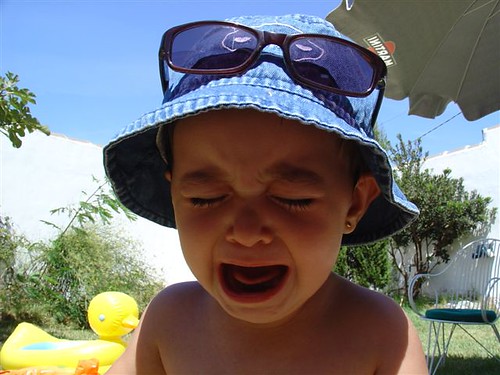
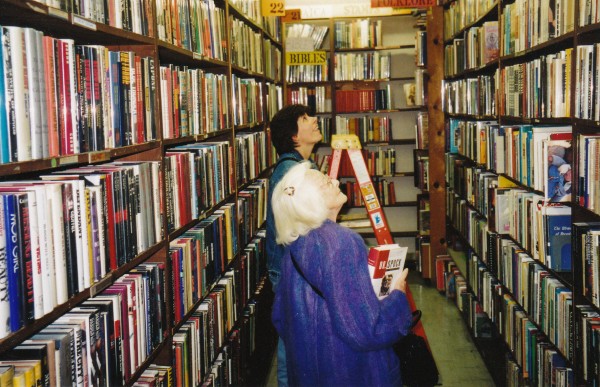
 In “Peaceful Babies—Contented Mothers,” pediatrician Dr. Emmi Pikler asks us to consider the importance of the touch of our hands.
In “Peaceful Babies—Contented Mothers,” pediatrician Dr. Emmi Pikler asks us to consider the importance of the touch of our hands.